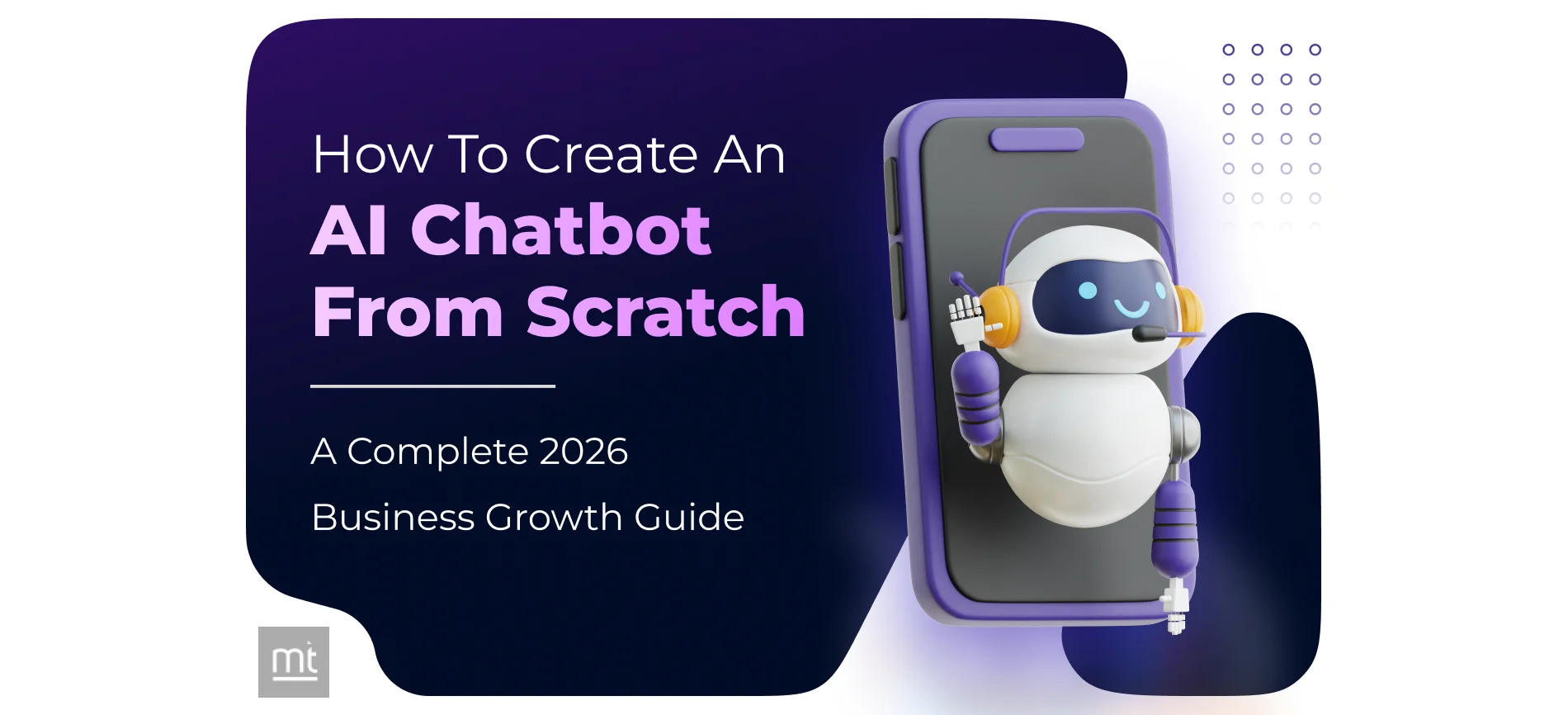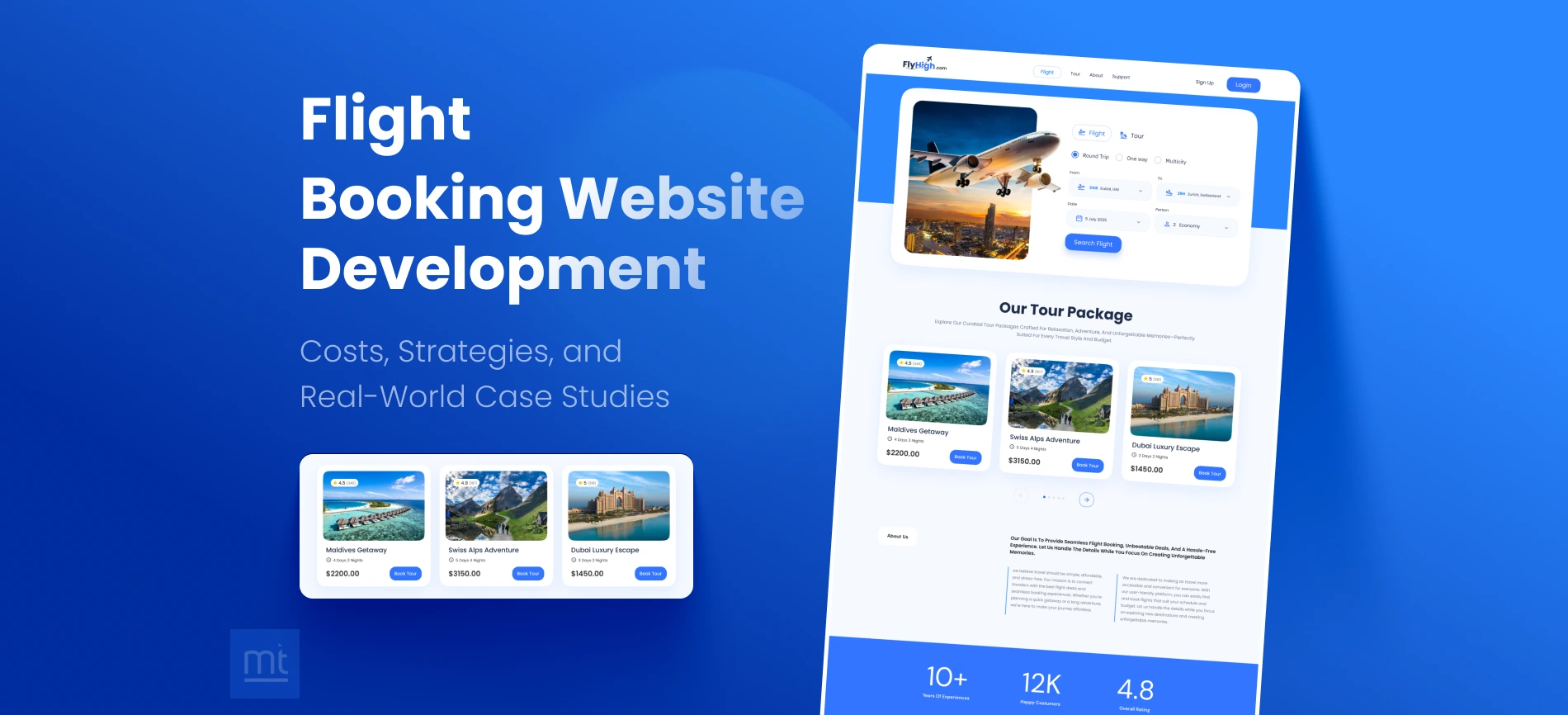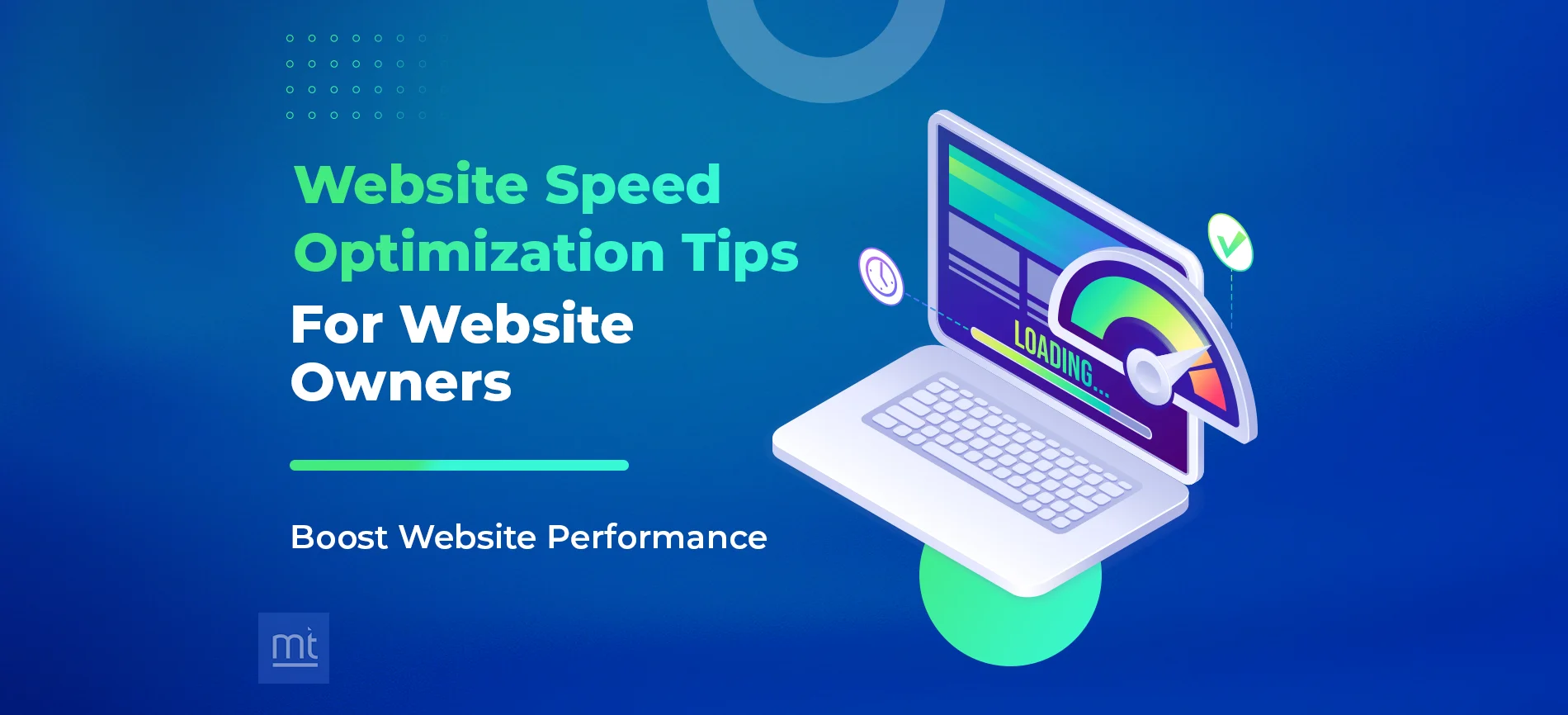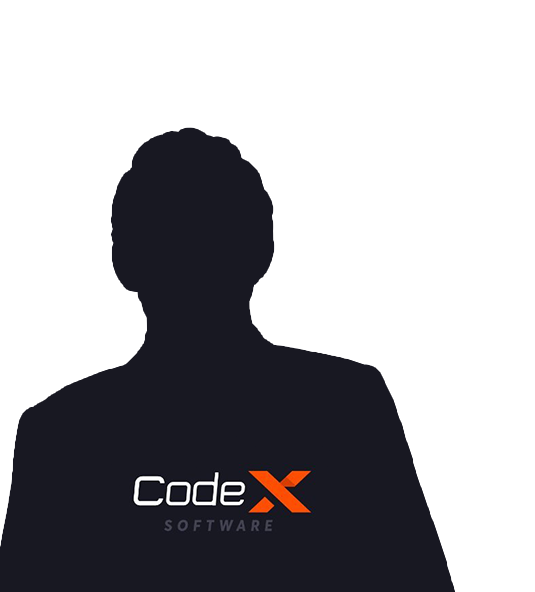Get Free Trial Week Developer Access, Try Before You Hire. Click Here to Claim Now
Introduction:
Can you imagine the frustration of the developer who has to code the entire software project using a technology that isn’t suitable to the requirements? It can lead to delays and frustration, and ultimately decide the fate of your project.
Choosing the right technology during the project planning stage is very important. It will ensure a robust and reliable framework that can help you deliver the project on time.
PHP and Codeigniter are two popular technologies that extend numerous features and powers to the developers. While PHP has been the cornerstone of web development, CodeIgniter extends efficient and streamlined workflows.
PHP has grown into a powerful framework, and CodeIgniter provides order to the chaos in the coding team. With significant pros and cons associated with each of these technologies, the choice becomes difficult.
This article will help understand what makes each platform better and what are some of the possible use cases. This will help you choose the right technology and accelerate your timelines by comparing CodeIgniter vs PHP for the best outcomes.
What is PHP?
PHP (Hypertext Processor) lays the foundation for the web development realm. It is one of the most powerful and robust open-source server side scripting languages.
As it uses HTML as the base language, PHP allows developers to create dynamic and interactive websites swiftly. You can use this simple and versatile technology to integrate with the dynamic databases, which makes it a good choice for the developers.
PHP is the go-to technology for developers who are tasked with creating simple blogs or complex enterprise apps. The framework comes alive with all the tools and pre-built solutions you need.
A Brief History of PHP
Rasmus Lerdorf wanted a technology to help manage his personal website, which is when PHP came into existence. The first version was known as Personal Home Page Tools. In 1995 the source code was released to the public, which helped attain more community contributions and led to the evolution of the technology.
The release of PHP3 in 1998 helped solidify the scripting language. In 2000, PHP 4 was released, which introduced the now famous Zend engine. The biggest milestone was the release of PHP 7 that came with performance and feature enhancements.
The Key Features of PHP
Here are the top four features of PHP that make it different from other web development technologies.
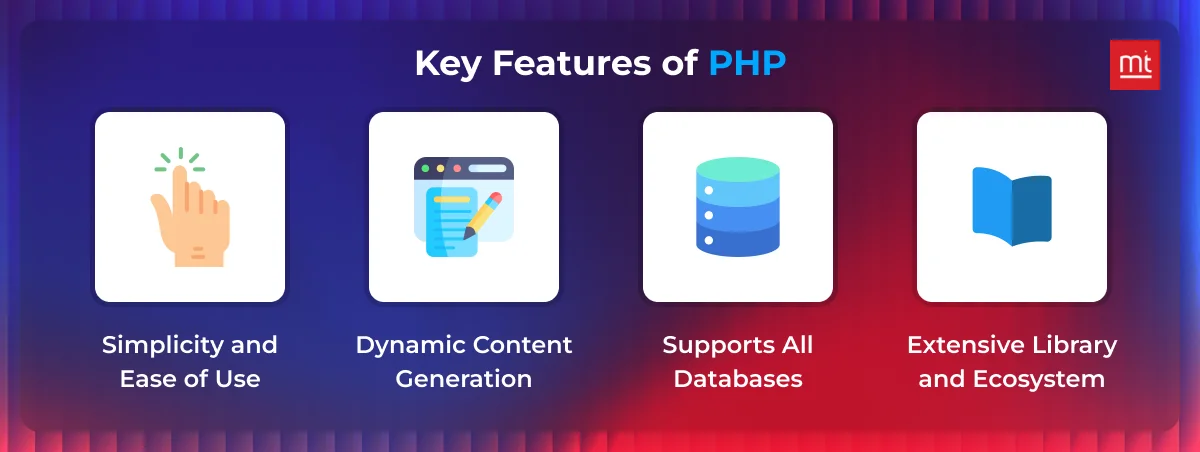
#1 Simplicity and Ease of Use
PHP extends a straightforward syntax, very similar to C. If you are a beginner and wish to explore web development, this is the perfect technology for you. You can easily create and deploy the scripts faster, reducing the development time and efforts.
#2 Dynamic Content Generation
Using PHP, your developers can create dynamic web content that interacts with various databases. You can craft data-driven websites and applications that are built to interact. Owing to this ability, PHP is a technology that can be used across use cases, from form building to content management system development.
#3 Supports All Databases
One of the biggest wins for PHP is that it can support all the databases. You can easily integrate the PHP website with MySQL, PostgreSQL or SQLite. It is known as a flexible technology owing to this seamless integration.
#4 Extensive Library and Ecosystem
The diverse library and in-built tools help developers speed up mobile application development with PHP. Using diverse frameworks, such as Laravel, Symfony and CodeIgniter, you can easily enhance productivity and reinvent the development wheel.
Pros of PHP
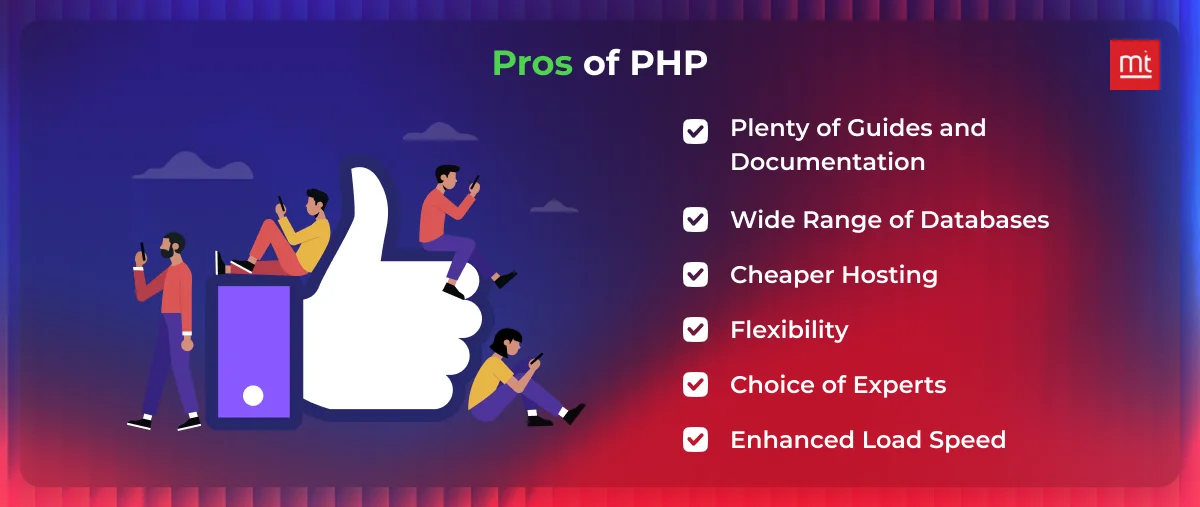
- Plenty of Guides and Documentation: PHP offers extensive and detailed documentation that helps developers identify the right solutions for the project. It also helps them incorporate the best practices for development.
- Wide Range of Databases: PHP can support numerous databases, such as MySQL, PostgreSQL and SQLite. This extends maximum flexibility to the database in the project.
- Cheaper Hosting: PHP offers diverse hosting services, which ensures affordability and popularity across web servers. It also ensures maximum compatibility with the servers.
- Flexibility: As it can collaborate with the diverse programming languages and technologies, it is a flexible solution for the software project.
- Choice of Experts: It has the largest community of developers, which means you can access numerous experts. It can also make it easier to find the right professionals for the project.
- Enhanced Load Speed: The technology offers maximum efficiency and performance that contributes to fast load times and enhanced user experience.
Cons of PHP

- Scarcity of Dedicated Libraries: PHP offers a vast ecosystem. However, it lacks the specialized libraries that are available with the other programming languages. This can limit the functionality to be added to the application.
- Sinking Popularity: With the emergence of newer technologies, the popularity of PHP is dwindling. There are fewer updates and innovations.
- Security Issues: PHP comes with security vulnerabilities, owing to the poorly written code and outdated practices.
What is CodeIgniter?
CodeIgniter is a PHP-framework that was designed to create quick and efficient web applications. It follows the MVC architecture (Model-View-Controller), which helps separate the application, logic, data and presentation layers.
As a result, developers can easily create and maintain the separate layers, thus ensuring better organization. It is a lightweight framework, ensuring speed and agility. Moreover, you can ensure cleaner code and organized development with this framework.
It is a great fit for beginners and experienced developers.
A Brief History of CodeIgniter
Developed by EllisLab and released in 2006, CodeIgniter has gained immediate popularity owing to the ease of use and detailed documentation.
8 years later, the CodeIgniter project was taken over by the British Columbia Institute of Technology, where they offered continuous support and maintenance. The version 3 and 4 were significant updates for this platform. With version 3, they introduced excellent features and stability.
The version 4 introduced modern practices for development and enhanced the app’s performance.
Key Features of CodeIgniter
All the top features that make CodeIgniter the best framework for web development.
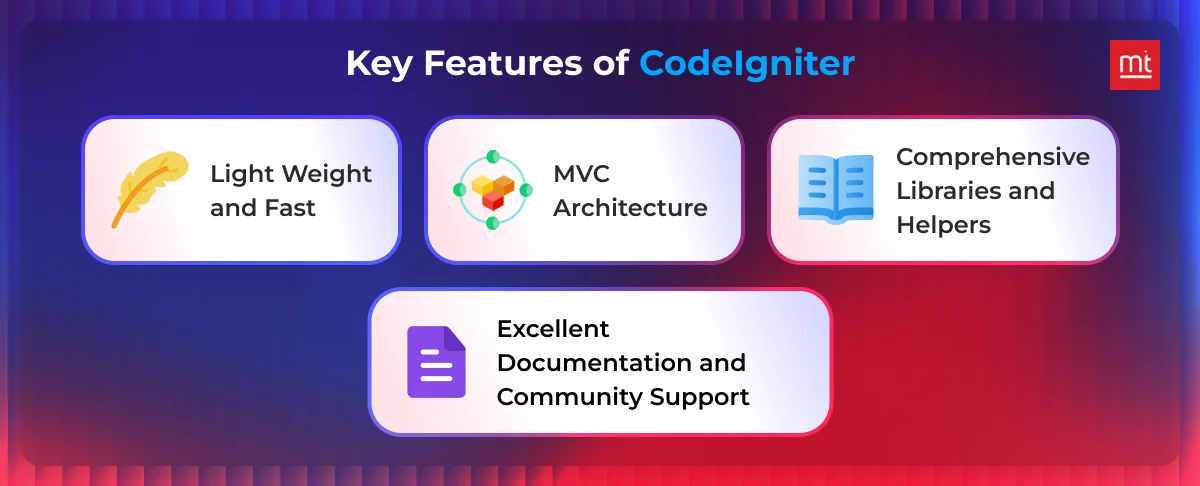
#1 Lightweight and Fast
CodeIgniter is a lightweight framework, which offers high performance and faster loading. Using minimal configuration, your developers can focus on building the application in a complex setting as well.
#2 MVC Architecture
As it follows the MVC architecture, you will notice a separate layer for logic, data and presentation. This helps improve reusability and simplifies the app’s maintenance. It makes development efficient.
#3 Comprehensive Libraries and Helpers
This technology offers diverse libraries and helpers to accomplish the common tasks, such as form validation, database interactions and session management. There are in-built tools that can reduce the need to develop code from scratch.
#4 Excellent Documentation and Community Support
There is detailed documentation available for the developers, which makes it easier for developers to get answers to their questions. There is an active supportive community that comes with forums, tutorials and third-party libraries.
Pros of CodeIgniter

- Smaller Footprint: It has a smaller footprint when compared to other PHP frameworks, which means need for less server resources. This can enhance the load time and performance of the web application.
- Modern Separation Concept: It follows the MVC architecture, wherein the application logic and presentation layers are separate. It helps maintain and manage the code, which allows developers to work freely on the different parts of the code.
- Built-in Security: in-built security, such as XSS (Cross-site Scripting), input filtering and CSRF (Cross-site Request Forgery) protection to enhance the app’s security and protect them against vulnerabilities.
- Easy Setup: The straightforward installation process eliminates the complex configuration while fast-tracking the development. It ensures simplicity, which benefits both beginner and experienced developers.
- Extendable and Customizable: You can extend and customize the framework with greater ease using the CodeIgniter technology. It helps add new libraries and modules easily to enhance the app.
Cons of CodeIgniter

- Lacks Comprehensive Libraries: This comes with core libraries that can pose a limitation when you need to create advanced functionality and out-of-the-box solutions.
- Lacks Focus on Code Maintainability: There are no strict coding standards or practices that can pose issues when you need to maintain the code. Moreover, you will find it difficult to maintain consistency in the codebase.
CodeIgniter Vs. PHP: What are the Key Factors to Consider?
Let’s do a quick PHP vs CodeIgniter comparison to understand how each technology works. We can assess them against top parameters to learn the better one.
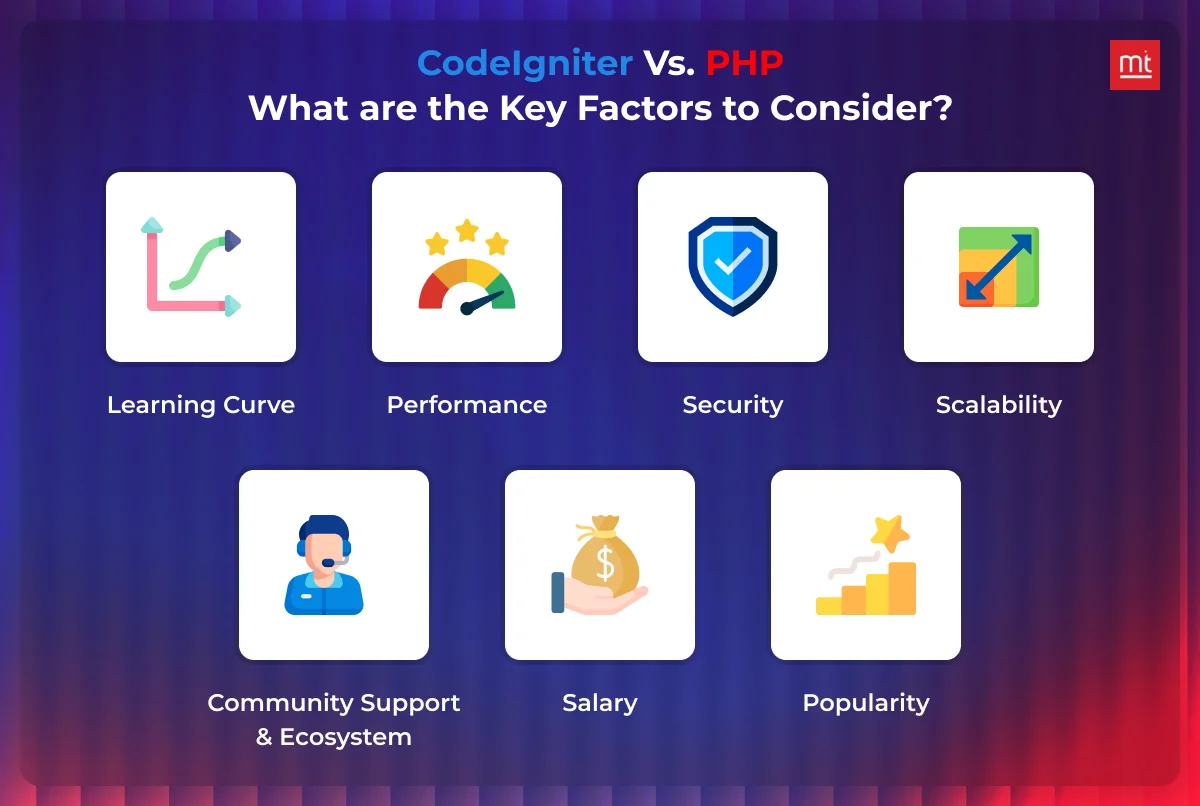
#1 Learning Curve
PHP: PHP is a straightforward language, which makes it easy and efficient for the beginner developers. As it is a versatile language with an easy to grasp syntax, it can be used across diverse applications
CodeIgniter: CodeIgniter is a PHP-based framework with conventions and structures of its own. It comes with a low learning curve; however, the developers need to familiarize themselves with the MVC architecture and syntax.
Winner: PHP is relatively easier to learn. However, CodeIgniter may take a few more steps to learn.
#2 Performance
PHP: PHP’s performance depends on how to write and optimize the code. While PHP is efficient, the performance is influenced by the coding practices and server configurations.
CodeIgniter: It is lightweight and designed to be fast. The performance can be good for several use cases as it offers a low footprint and efficient execution. However, it may not be possible in case of complex applications.
Winner: PHP is best if you want an all-round performance, irrespective of the complexity.
#3 Security
PHP: PHP offers security that depends on the best practices incorporated by the developer. PHP provides the basic functions that help secure the applications. However, it largely depends on how the developers implement these practices.
CodeIgniter: CodeIgniter offers in-built security features like the CSRF protection and XSS filtering. This helps ensure a higher level of security for the software applications.
Winner: In the debate between CodeIgniter vs PHP framework, CodeIgniter offers in-built security solutions, and a higher-level solution, which can help build capable solutions.
#4 Scalability
PHP: You can scale PHP technology effectively. However, it depends on how well the application is structured and optimized. There are no inherent scalability features available. You will need to ensure the infrastructure is scalable.
CodeIgniter: You can use CodeIgniter for small to medium applications. However, it cannot be used for large-scale applications, as you may need additional architecture for this purpose.
Winner: PHP technology is highly scalable and can be effectively used for small-to-medium size applications.
#5 Community Support and Ecosystem
PHP: There is a large and active community supporting growth of PHP technology. The extensive resources, documentation and forums that support your understanding. Moreover, the vast libraries and extensions can help support the development of applications.
CodeIgniter: CodeIgniter follows a supportive community; however, it is smaller when compared to the PHP community.
Winner: PHP is a better framework when compared to CodeIgniter in terms of community support and ecosystem.
#6 Salary
PHP: There is a huge demand for PHP developers and there is a large salary expectation around skills and experience. This is one of the most in-demand job opportunities.
CodeIgniter: The salary for the developer will depend on the specific framework demand in the project. This is less common, which is why there are fewer job opportunities available in the market.
Winner: PHP is comparatively high cost when compared to CodeIgniter.
#7 Popularity
PHP: PHP is a relatively popular language and has been actively used in web development. You can leverage its popularity to access the large talent pool and resources.
CodeIgniter: This is a popular PHP framework; however, it is not as popular as the others. This limits the talent pool and access to the resources.
Winner: PHP has a more accessible talent pool and extensive resource availability in the PHP vs CodeIgniter comparison.
Overall PHP offers better resources and documentation. However, when it comes to security, CodeIgniter is a great technology. This helps us understand the difference between PHP and CodeIgniter.
Choosing a good technology is important for your upcoming software project. Here are all the ways in which you can make the right choice.
How to Choose the Right Technology?
Here are all the factors to consider when choosing the right technology for your software development project.
#1 Define Requirements
Identify the goals of the project and what you aim to achieve from the project. It is crucial to list all the features and functionality before you begin choosing the technology. Make sure to list the non-functional requirements as well, such as performance and security along with scalability.
#2 Assess the Technology
When you are planning, you must decide whether you need a technology or a framework to manage the development. In this case, PHP would be the language, while CodeIgniter would be the framework. Moreover, you must assess the technology compatibility with your existing systems.
#3 Evaluate the Learning Curve
When you are evaluating the technology, know the learning curve for the technologies involved. Assess how easy it is for your team to learn the technology or framework to kickstart the project. Similarly, identify the resources and tutorials available online for the same.
#4 Determine the Performance and Scalability
You must check the performance and scalability of the technology of the framework to manage the expected and unexpected loads. You must also check if the technology can easily scale to meet the increased demand.
#5 Gauge the Security Features
Know if the in-built security features can align with your security needs. Additionally, check if there are best practices to ensure secure development.
#6 Review Community Support
Check if the community will support with the requisite resources and documentation. This will ensure there are people who are available to support you when you are stuck in the development. You must also evaluate the ecosystem for the technology before proceeding with it.
#7 Determine the Costs
You must calculate all the costs involved in planning the software development. You should also consider the development cost and resources when planning the application. You should factor in the ongoing maintenance and support costs before finalizing the budget.
Conclusion
Choosing the right technology is imperative if you want to successfully launch a software application for your business. It will help you manage the processes, streamline the development and ensure a smooth launch.
A sound technology with the right backing from the community can ensure you have enough guidance and support to resolve your issues and accelerate the launch.
ManekTech is a leading software development company that helps with managing the ideation-to-launch phase for your business. We also help outline the best technology and solution for your idea.
If you have a concept or a pre-developed idea, connect with our team for a full-fledged solution.

Recent Blogs
Subscribe to Our Newsletter!
Join us to stay updated with our latest blog updates, marketing tips, service tips, trends, news and announcements!


